BOH游客中心,金马伦高原,彭亨,马来西亚
2011-07-30司马蕾
项目面临的主要挑战
项目的大多数材料要求由本地工厂制造,原料也要求就近供应以减少成本,满足客户有限的预算。同时,要找到技术符合要求的承建商也非常困难,这是因为我们要求他们能理解设计的概念,并能在立面施工上做出特定的各种细部。
建筑要求自然通风,并要注意避免害虫侵入以满足运营的安全要求。建筑也必须全天候向游客开放,为设计带来很大的挑战。
进入建筑需要通过既有的场地,也要保证货车能绕着场地通行以运送从工厂送出的茶叶,新建筑和既有的茶叶加工厂间需要保持一定的距离。客户公司的经营活动在紧邻工厂的一座楼房中进行,因此,新建筑的设计也要避开这座楼房。同时,在整个新建筑建设的过程中,公司只搬迁一小段时间,此外的其他建造阶段均需保证经营活动能持续进行、不受干扰。另外,保证现有的两层办公楼结构不受影响也是一项巨大的挑战。紧邻预定的设计范围还有一棵大树的树根需要保护。因为砍掉树木会造成许多问题,我们制定了一个不需要砍树的设计方案。
在项目的第二阶段设想可以建设些别墅。但由于场地的限制,为了保证未来的扩建不会影响现有建筑,别墅被安排在与游客中心相对的一侧。
设计策略
设计中尽量选用易于制造和安装的简单建材。窗户的设计上采用了多处折角来利于排雨,而在需要自然通风的区域则在窗上安装了格栅和木遮阳板,以在保证空气流通的同时避免雨水进入。
平面设计让货车能够绕着其外侧通行,同时注意避免货车路线的变化,以让旧货车也能到达工厂。这也利于适应茶叶一直以来的运输方法。游客中心不直接和工厂相连,因此行人能穿梭于建筑的各个侧面,也能更好地理解场地周边的环境。为了在保证游客安全的同时能控制步行人流,一层楼面比地面抬高了一定高度。建筑内只有一个出入口,利于人流的控制,而客户要求的零售店的商业活性也因此更佳。
为了减少对客户公司经营的影响,建筑采用了钢结构以利于在结构的交接处和避开树木及柱子设置隔断。这种方式也让原有办公楼能融入新建筑的平面之中。
整个建筑的一层都被架空,卡车和其他车辆能从其下通过而不会影响游客中心的运营。我们使用了缓坡来抬升建筑的中心部分以避免在其中设置楼梯或台阶,这也利于在将来有需要的时候拆除建筑中心的部分以让更大的机动车通过。
因为这一地区经常性的暴风雨天气和强风会刮断树枝,屋顶结构经过了加固以抵御落枝的冲击。□(司马蕾 译)
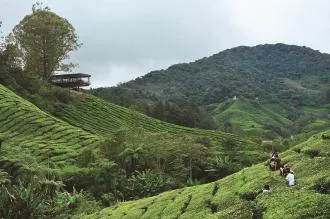
1 Boh茶园/Boh Tea Centre
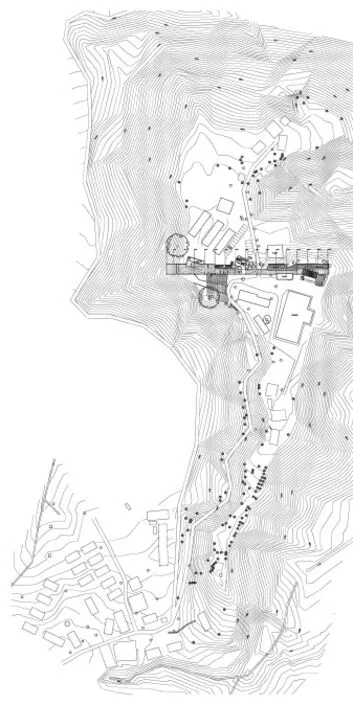
2 位置/Location
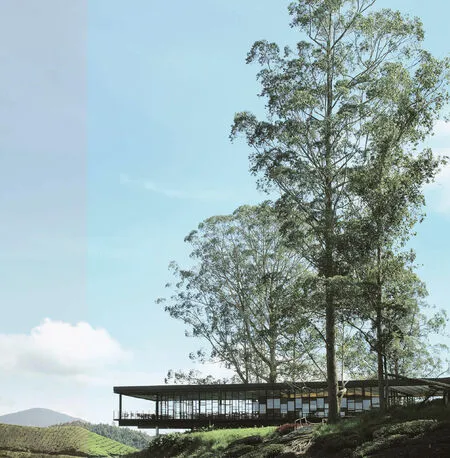
3 外景/Exterior view

4 立面/Elevation

5 剖面及总平面/Section & site plan 1-主入口/Main entrance 2-画廊/Gallery 3-咖啡厅/Cafeteria 4-厨房/Kitchen 5-卫生间/Wash area 6-零售/Retail 7-仓库/Storage 8-视听室/AV room 9-展室/Exhibition 10-停车区/Parking area 11-老厂房/Old factory

6 外景/Exterior view

7 外景/Exterior view
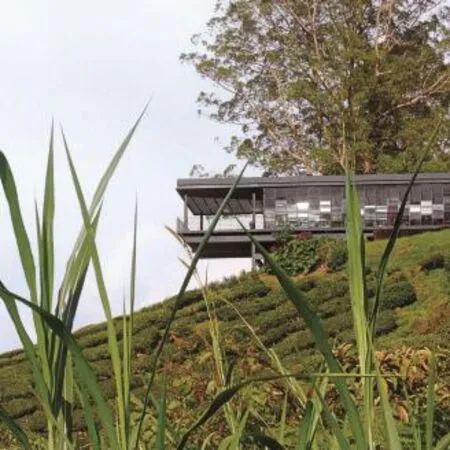
8 外景/Exterior view
Principal Project Challenges
Most of the work had to be done from the local factory, and materials have had to be sourced from a close-by supply to reduce impact on our cost and the Client's limited budgets. It was also very difficult to find the skills required of contractors who understood the design concepts, and the particular details we wanted for the facade.
The building had to be naturally ventilated,and thought hard about how to keep vandals and vermin alike, out of the building whilst maintaining sufficient levels of security for the operators. With that we also had to keep the building open-able at all times for visitors. This posed a great challenge for us.
The building also had to be accessed from the current locations, and we had to be sure of keeping the tractor movements around the site with delivery of the teas from the estate, with that we had to leave a gap between the new structure and the existing factory where the teas are processed. The Client kept their operations in a building located very close to the factory, and we had to construct and design around this building, whilst keeping operations intact and uninterrupted throughout the entire construction phase except for a time when they had to move out for short period. With that it was a real challenge also to make sure no structural disturbance was to be imposed to the existing 2 storey houses where the Client offices were located.There was also a very big tree we had to keep whose roots were very close to the building we wanted to put up, which would have posed enormous problems if it ever felled. We devised a plan layout to avoid cutting it down.
In phase 2 of the project, it was envisaged there might be chalets, however due to the limited site access, we had to allow for future expansions without having to demolish this building, although the chalets may be located to the opposite side of the visitor centre.
The Design Solutions
We sourced materials which are readily available, and that would be easy to fabricate and install. Our window designs permitted various angles for rain cut off, but also for areas requiring natural ventilation we devised fixed louvers and wooden cladding that allowed air to pass through without adverse rain penetration.
The building plan we devised permitted existing movements of the tractor to pass ahead of the facade, and we avoided any changes to the track ways and routes for the old tractor to make its way up to the factory. This in turn was an attraction,as it demonstrated the ways tea was delivered as it had been for a very long time. Also the visitor centre was not directly connected to the factory,this made it possible to walk across, an experience that allowed one to appreciate the context of the site better. For visitor security and controlling the flow of pedestrians, we had lifted the floor plan slightly above ground, and this also gave the Project its lightness, and feeling of floating above ground.The building has good control of people movements as the internal layouts allowed only one single entry point to the building and this made commercial sense of the retail design that was desired by the Client's operations.
In order to minimize disturbances and interruptions to Client operations, the building devised a system of steel frames that permitted cutting out of floor areas where existing structures had to be retained, and also where a tree or a column had to be avoided. The cut outs also permitted for the Clients offices to be integrated into the floor plan.
The whole structure was elevated in the centre, to allow for trucks and vehicles to pass under, without major disruptions to the operations of the Visitor Centre. With that we introduced a gentle ramp that elevated the centre of the building very gently without any need for stairs or steps internally, but also in the future it was still possible to dismantle the centre of the building to allow larger vehicles to pass through if required.
The roof structure has been reinforced to account for felling trees, as the chances of branches breaking off are high given the frequent stormy weather and its high winds in this area. □

9 材料/Materials

10 材料/Materials

11 材料/Materials
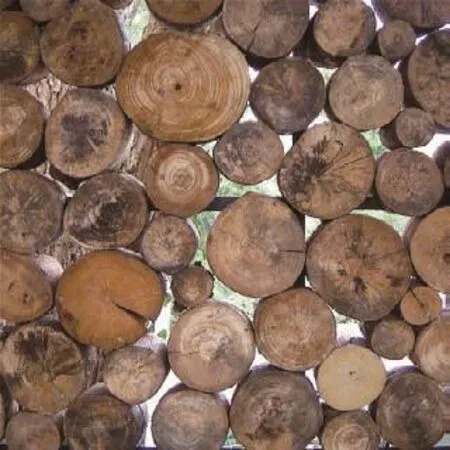
12 材料/Materials

13 入口立面/Elevation of the entrance

14 展室立面/Elevation of the exhibition

15 商店立面/Elevation of the shop

16 咖啡厅立面/Elevation of the cafeteria
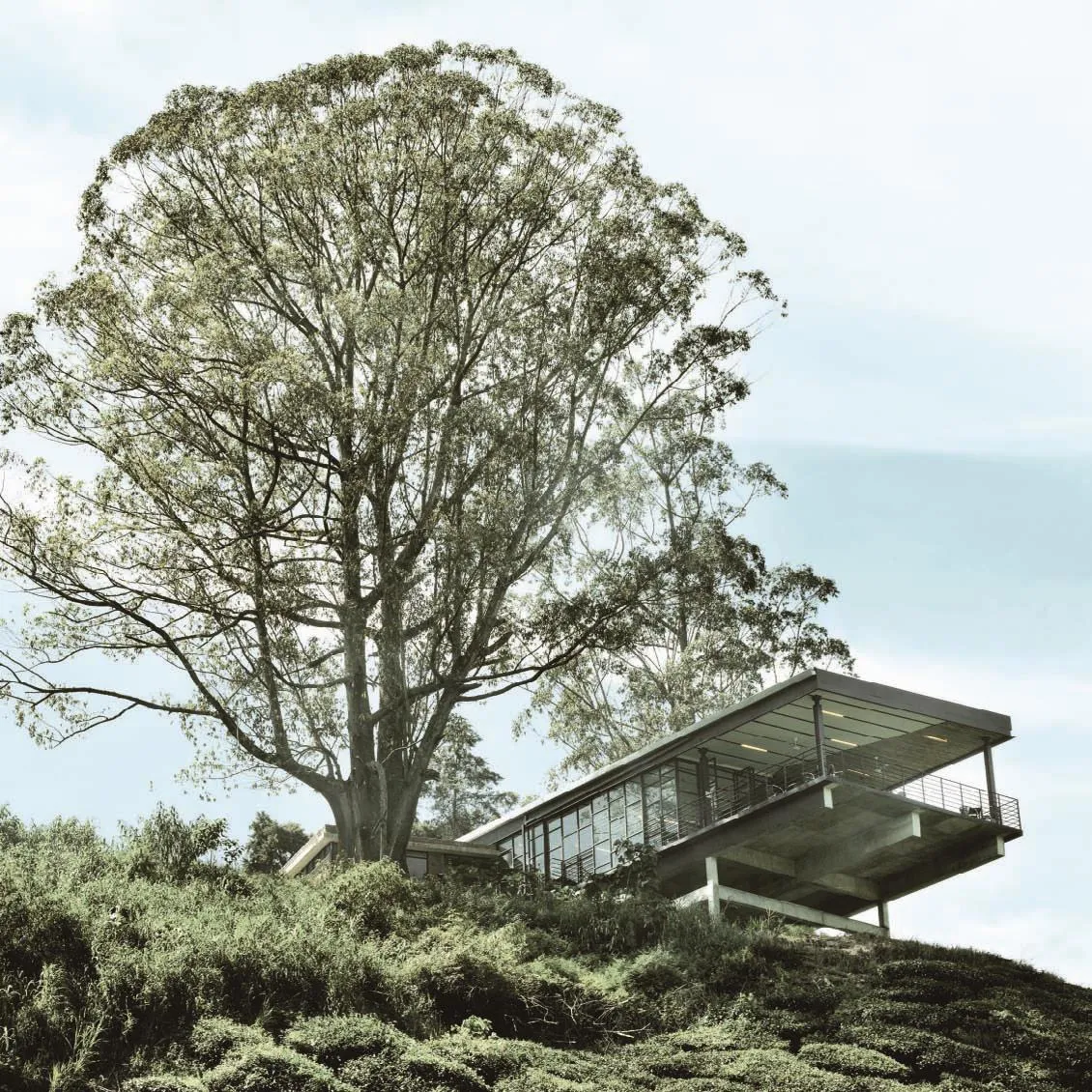
17 外景/Exterior view
